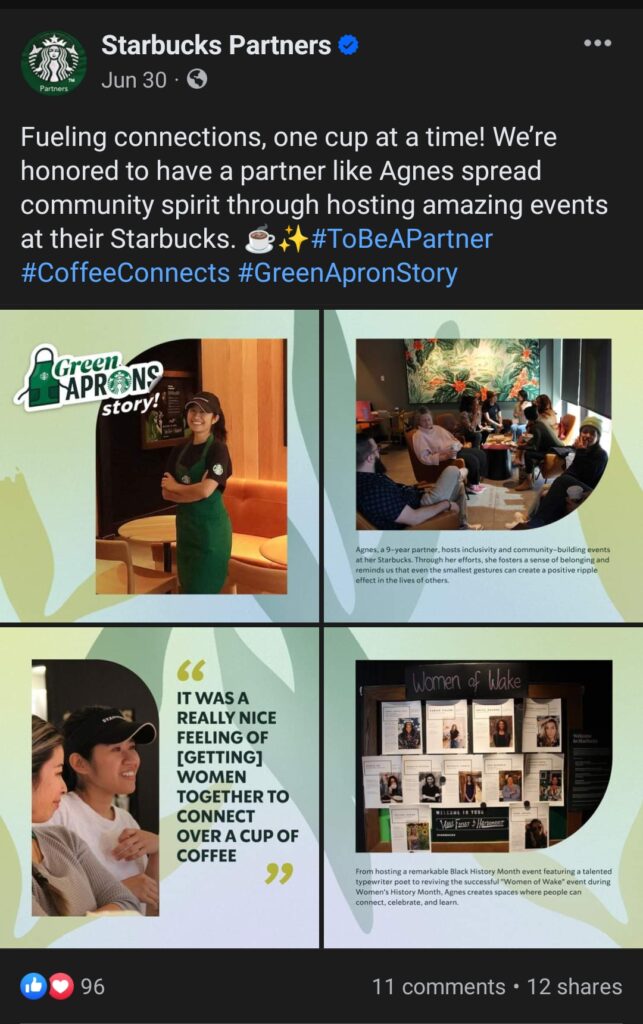
In today’s competitive business landscape, your company’s corporate branding plays a significant role.
As you know, it is more of a broader approach as compared to product branding or service branding.
Corporate branding involves developing a distinctive brand identity, trust, and reputation that resonates with your customers, your employees, your investors, media, and general public.
Often times traditional marketing strategies fall short in establishing an authentic and influential brand presence. Don’t lose your hope as there is one way to strengthen your corporate brand.
Enter employee advocacy.
It is a powerful approach that leverages the collective voice and influence of employees to amplify a company’s message and foster stronger connections with the outside world.
In this blog post, we will explore the concept of employee advocacy, how it strengthens your corporate branding, and the best practices you can consider.
What is Employee Advocacy?
Employee advocacy refers to the practice of promoting your company by your employees, voluntarily.
As the name implies, employees can act as ‘brand advocates’ who can spread awareness about your products, services, or your company as a brand.
This kind of organic, employee-driven promotion can happen online or offline. In this era, the most common and effective to do this is on digital channels.

For instance, your employees can easily share company content (like blogs, infographics, videos, photos, job listings, etc) on their personal social media accounts.
Not only that, employees may share their experience of working in your company, their participation in company-hosted events or other industry-related events.
Introducing Maxsemo’s FREE SEO Tools to Boost Your Search Visibility on YouTube.
✓ no ads
✓ free to use
By sharing relevant content and insights that resonate with their audiences, these employees can become your brand ambassadors.
This organic approach adds a human touch to corporate branding efforts, fostering trust and credibility in a way that traditional marketing cannot achieve.
How Employee Advocacy Strengthens Your Corporate Branding?
Employee advocacy plays a crucial role in strengthening corporate branding and here’s how it works for your company.
1. Authenticity and Trust
Employee advocacy brings an element of authenticity to corporate branding.
When your employees share their genuine experiences, expertise and enthusiasm for your company, it builds trust with their networks.
People are more likely to trust recommendations from individuals they know rather than from marketing messages. This trust strengthens the overall perception of your company brand.
2. Enhanced Reach and Visibility
Your employees have their own personal and professional networks built both online and offline.

By actively advocating for your company via their social media and offline networks, they expand the reach of your company’s messages, content, and brand presence.
This increased visibility helps in reaching a wider audience that includes your potential customers as well.
3. Thought Leadership
Encouraging employees to share their knowledge and insights about the industry and your company’s product/service offerings.
When employees establish themselves as thought leaders, it enhances your company’s reputation and positions your company as an authority within the industry.
This thought leadership contributes to the overall brand value and can attract customers, partners, talent, investors, and mainstream media.
4. Employee Engagement and Satisfaction
Encouraging employees to advocate for their company fosters a sense of pride, belonging, and engagement.
It demonstrates that their voices are valued, and they are important contributors to the brand’s success.

Very active employees are more loyal, motivated, and dedicated to delivering exceptional customer experiences, which positively impacts the corporate brand image.
5. Talent Acquisition and Retention
Your company becomes an attractive proposition for potential job applicants when it has a strong corporate brand, supported by employee advocacy.
When employees advocate for your company, they portray it as a great place to work, fostering a positive employer brand.
This enables you to attract and retain talent in your organization.
6. Restoring Your Company’s Reputation
Employee advocacy can help in mitigating the impact on branding when your company faces a crisis or negative publicity.
Your employees can provide a counter-narrative like sharing positive experiences, addressing concerns directly, and publicly support company’s reputation repair efforts.

Their advocacy efforts demonstrate solidarity, transparency, and a commitment to rectifying any issues, thus helping to rebuild trust and repair your company brand’s reputation.
7. Upper Hand Over Your Competition
When your company is operating in a competitive domain, you can stand out when you have a strong employee advocacy program.
The authentic and personal touch of employee-generated content differentiates your brand from rest of the pack and fosters brand loyalty.
Four Employee Advocacy Examples for Your Reference
1. Starbucks
Famous coffee beverages brand Starbucks have a successful employee advocacy program in all of its locations worldwide.
They have encouraged their employees to share their experiences, responsibilities, and career updates on different social media platforms, under the name of ‘Starbucks Partners’.

Their employee advocacy efforts are helping the company in boosting its brand reach and other companies are using Starbucks’ advocacy program as a reference for creating their own programs.
2. Randstad
Randstad is a global leader in the human resource consulting domain.
The company’s mission is to support people and organizations in realizing their true potential by combining the power of current technology with their passion for people.
They created an employee advocacy program which consisted of training, content creation, and supporting different lines of Randstad’s business.

After Randstad launched the advocacy program in 2016, their potential reach has increased to over 100,400,000 people.
The company witnessed increased content engagement by over 100,000 interactions.
They received 597,000 click-throughs their website and generated over $1,500,000 in earned value.
3. General Electric (GE)
GE called their employee advocacy program as employee brand ambassador program.
According to MackCollier.com, GE created this advocacy program to solve a specific problem the company was facing.
GE was facing difficulty in hiring people as the big part of the problem was a negative perception around their brand.
Applicants viewed GE as a sort of monolith corporate entity, and GE’s employees weren’t much active online and they aren’t doing a very effective job of telling the brand’s story.
In short, job applicants didn’t understand why they should want to work at the company.
So, the company involved HR managers and talent acquisition team in the program.
HR managers were trained and they in turn worked with employees on how to improve their online presence and how to better ‘humanize’ the GE brand.

The brand saw an 800% increase in job applicants within few months of leveraging its trained ‘employee brand ambassadors’ who can better tell GE’s story.
The company has found that they don’t need to rely on traditional advertising to support the hiring initiative since its employees are more engaged online.
4. Boston Consulting Group (BCG)
BCG is a US-based global management consulting firm and the company felt that they are not reaching out to their audience with full potential.
Even though the company produces shareable and high-quality content, they need to find an effective way to get their content out to their target audience.
BCG found that their consultants (employees) possess a larger and engaging audience than the brand had its own.
Also, most of them are very much active on Linkedin. So, they created an employee advocacy program with the goal of taking the least amount of effort for their consultants to share content.

With all of their content centralized, BCG consultants were sharing nine times as frequently and it greatly helped BCG in their objective of becoming more of a thought leader in the industry.
10 Employee Advocacy Best Practices You Need to Know
It’s time for your marketing team to harness the power of your workforce to boost your company’s presence as a corporate brand.
Here are ten employee advocacy best practices you can consider when creating an advocacy program for your own company.
1. Create a Positive Work Atmosphere and Culture
In order for employee advocacy to be successful, a company should create a positive work atmosphere and culture for its employees.
You need to encourage your workforce to open communication, recognize and reward their efforts.

Foster a culture where you need to be transparent and honest to your employees. Give them opportunities to grow skill-wise and career-wise.
Share your company’s goals, challenges, and successes with your workforce.
2. Provide Proper Guidelines and Training Sessions
Before ‘enrolling’ employees into your advocacy program, offer them training sessions on social media etiquette, personal branding, data protection, and brand guidelines.
Empower employees with the knowledge and tools that can help them to be effective as brand advocates, while safeguarding your company’s reputation.
3. Lead by Example
You want to motivate employees to take part in advocacy then as a business owner you have to do it first.
When company leaders and managers start involving in advocacy efforts then it sets a positive precedent and encourages others to join in.
You can leverage your personal brand status to motivate your employees to participate in the advocacy campaigns.
Check out this article if you want to build your personal brand as an entrepreneur.
4. Offer Incentives
While advocacy is voluntary, incentives can motivate employees to actively participate.
To create a sense of healthy competition and drive sustained engagement, it is necessary to recognize and reward to advocates.
5. Find Employees Who are Influencers as well
In your workforce, there are employees who are very much active on social media and have considerable following.
Find those influencers whose audience you can target with your company content and messages.

You can find many ‘nano-influencers’ among your workforce who have small-yet-highly engaging followers with whom you can collaborate.
Everyone in your office may not be active in participating (mainly due to work related reasons) in advocacy efforts.
Yet, you can rely on these influencers to spread your message out as they love to create and showcase content for their respective audiences.
6. Curate Quality Content
Content curation is the process of finding and sharing excellent, relevant content to your social media followers.
This process helps in establishing yourself as a thought leader or an expert in the industry.
You can do same through your employee advocacy program. Provide employees with a steady stream of high-quality content (articles, survey reports, industry statistics, podcasts, etc) that aligns with your company’s values and objectives.
Engaging and informative content make it easier for employees to share and resonate with their audience.
7. Encourage Participation from Different Departments
You need to encourage employees from different departments to participate in your employee advocacy efforts.
For example, if you are running SaaS company don’t let limit participation from software development department.

Encourage participation from HR, marketing, finance, and sales departments as well.
You can also consider gamification tactics like introducing a friendly competition or rewards system to motivate employees to participate in advocacy campaigns.
8. Employee Generated Content for Your Channels
As a part of advocacy program, invite employees to write articles for your company website and create video or infographic content for your social media channels.
This humanizes your brand and strengthens connection with your audience.
Similar to employee generated content is the user-generated content (UGC). UGC is created by your customers/clients or your brand followers.
9. Offline Advocacy
Employee advocacy is not just an online-only process.
Encourage employees to share company’s story, achievements, and values through conversations at networking/industry events, conferences, trade shows/exhibitions, and personal interactions.
10. Measure and Track Results
Set clear goals for your employee advocacy program so that you can accurately track the results.
Analyze the impact of employee advocacy on corporate brand visibility, customer engagement, lead generation, and mentions in media/public conversations.
You can use the data from the current advocacy program to improve and optimize your future advocacy campaign.
Conclusion
Employee advocacy is a powerful tool that can elevate a company’s corporate branding efforts to new heights.
By harnessing the authentic voices of your workforce, your company can establish credibility, reach a wider audience, and foster meaningful connections with your customers and other stakeholders.
What do you think? Let me know your thoughts in the comment section below.
